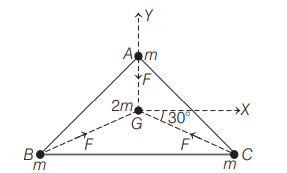Q.
Three equal masses of $m \,kg$ each are fixed at the vertices of an equilateral triangle $A B C^{\prime}$ and a mass $2 \,m$ is placed at centroid $G$ of the triangle as shown below.

The force acting on a mass $2 \,m$ placed at the centroid $G$ of the triangle is
Gravitation
Solution:
